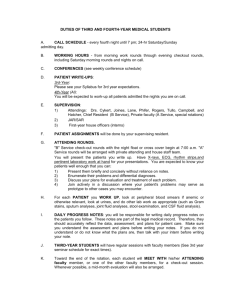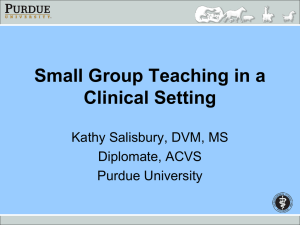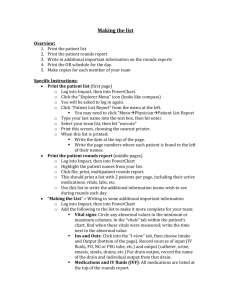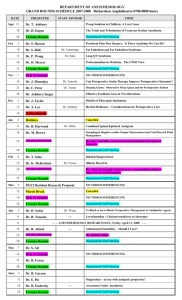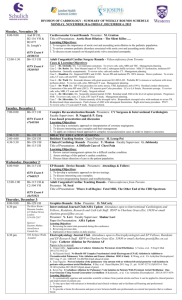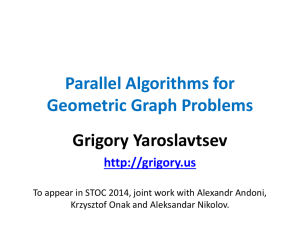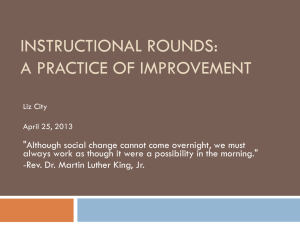From the Quality Teaching model to Quality Teaching Rounds
advertisement
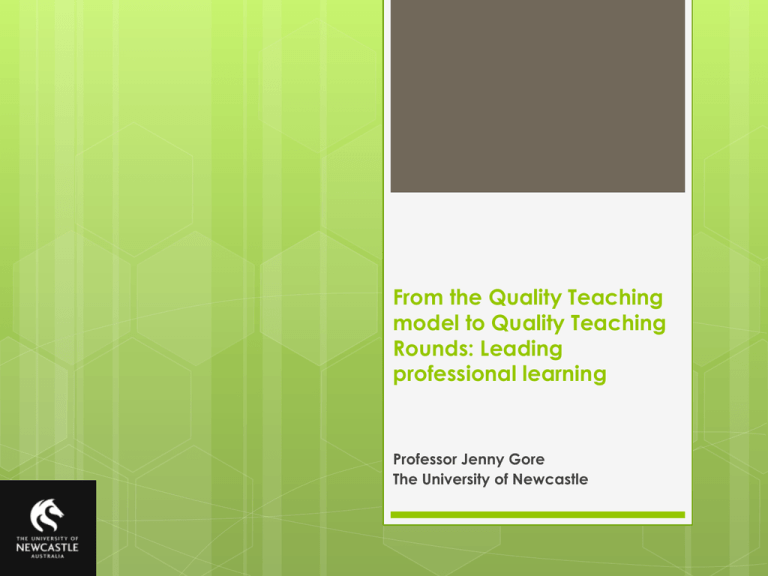
From the Quality Teaching model to Quality Teaching Rounds: Leading professional learning Professor Jenny Gore The University of Newcastle 2 Support such as protocols, leadership, facilitation IMPACT Design of approach to professional development PROCESSES DESIGN Complex field of teacher professional learning Teacher learning, teaching practice, student outcomes 3 Principles of effective PD 1. 2. 3. 4. 5. Adequate time for professional learning Collaboration among teachers Reflection on practice A coherent professional learning program Participation in active rather than passive learning 4 We have worked, collectively and separately, in dozens of school districts where there was no common point of view on instruction, where ten educators from the same district could watch a fifteenminute classroom video and have ten different opinions about its quality, ranging the full gamut from high praise to excoriation. Gaining an explicit and widely held view of what constitutes good teaching and learning in your setting is a first step toward any systematic efforts to scaling up quality. (City et al.,2009 p.173, emphasis added) Quality Teaching - Dimensions and Elements Note: * Marked elements do not pertain to the coding of assessment practice. 5 Underlying mechanisms A comprehensive approach to teaching Focus on curriculum decisions Clear goals for and commitment to learning for all students A supportive approach to teacher development 6 Overview of data collection SIPA 2004 - 2007 *1942 teachers, several of whom completed the questionnaire in more than one year of the study 7 Deep Knowledge coding scale To what extent does the knowledge addressed in the lesson focus on a small number of key concepts and the relationships between them? 1 Almost all of the content knowledge of the lesson is shallow because it does not deal with significant concepts or ideas 2 Some key concepts and ideas are mentioned or covered by the teacher or students, but only at a superficial level. 3 Knowledge is treated unevenly during instruction. A significant idea may be addressed as part of the lesson, but in general the focus on key concepts and ideas is not sustained throughout the lesson. 4 Most of the content knowledge of the lesson is deep. Sustained focus on central concepts or ideas is occasionally interrupted by superficial or unrelated ideas or concepts. 5 Knowledge is deep because focus is sustained on key ideas or concepts throughout the lesson. Intellectual Quality of lessons Difference between primary and secondary is statistically significant (t=4.469, df=662, p<.01) 9 Quality Learning Environment of lessons Difference between primary and secondary is statistically significant (t=7.946, df=662, p<.01) 10 Significance of lessons Difference between primary and secondary is statistically significant (t=2.219, df=662, p<.05) 11 Quality Teaching and Equity Students with low prior achievement get poorer quality pedagogy Indigenous and low SES students get poorer quality pedagogy Better pedagogy is correlated with narrowing of achievement gaps for indigenous and low SES students Teachers’ dispositions and beliefs are related to the context in which they work 12 Quality Teaching Rounds Developed for the ARC Linkage project Effective Implementation of Pedagogical Reform, 2009-2012 – Gore and Miller CIs; Bowe, PhD candidate; Bowe and Roy, facilitators Taking place in 4 schools, with 7-8 teachers in each school forming a professional learning community (principal included in 3) Combines aspects of professional learning community, instructional rounds and the Quality Teaching model 13 Literature on teacher buy-in Convinced effect on teaching practice and student outcomes Explore and understand concept in relation to beliefs and values Active collaboration and dialogue Trusting, supportive atmosphere External facilitation Coherence in professional learning and in reform agenda Extended professional learning time Leadership support 14 Professional Learning Community long-term, ongoing commitment to a group the capacity for the development of trust and respect colleagues with whom to debate and explore practice scope for breadth of insights/diverse views to be articulated 15 Rounds process turn taking which requires all participants to share their practice a common experience as a basis for analysis and discussion deprivatised practice a focus on describing practice 16 Quality Teaching model a lens through which to comprehensively notice and assess what it happening in any lesson -- both for the teacher and for the students a tool for the systematic and specific analysis and judging of lesson quality a focus on the lesson rather than the individual teacher a framework from which to commence important conversations not only about the specific lesson observed but also about teaching in general 17 Anatomy of a Rounds day Session 1: Professional reading to develop a shared knowledge base, includes interrogation of the Quality Teaching model, explicitly providing constructive spaces for alternative points of view. Session 2: Classroom observation by all members of the PLC. A common experience on which to base discussions using the shared lens of Quality Teaching. Session 3: Coding and discussion of the observed lesson drawing on the language and concepts of the Quality Teaching model. Teachers make judgments about the observed practice based on their own experience, knowledge, and insights. Disconfirming evidence or alternative experiences and views are discussed. Note: Teachers are encouraged to reflect on their own practice and broader practices within the school, so that the professional conversation moves beyond the observed lesson. 18 19 The sample Group A: 28 teachers who participated in Rounds, 21completed survey in 2009 Group B: 47 teachers at schools where Rounds were being conducted but not participating Group C: 256 teachers at 12 other schools in same school system that had participated in QT Rounds pilot and prior QT professional development Group D: B +C = 303 Survey scales teachers’ view of the coherence of professional learning in the school; teachers’ view of the coherence between Quality Teaching and aspects of the school organisation: teachers’ views of the effectiveness of their professional learning experiences; teachers’ estimate of the level of trust among teachers in the school; the degree to which they feel supported to engage with Quality Teaching; how favourably Quality Teaching has been received in their school; how important Quality Teaching is; and, the degree to which they take responsibility for student learning. 20 SUMMARY This comprehensive approach to teacher professional learning, an approach that focused teachers’ attention on student learning, actively and collaboratively engaged them in making sense of the reform, and provided them with extended time and other symbolic and practical forms of support, enabled them to experience coherent and meaningful professional learning. These data augur well for the potential of Quality Teaching Rounds within professional learning communities to substantially impact on teacher professional learning. 22 Developing Teachers’ Pedagogical Understanding I think that it’s the best approach to changing your thinking and changing your classroom practice that I’ve been involved in…This rounds approach means that you’re in the thick of it straight away. There’s no hiding, there’s no – like it’s you’re in there and you’re doing it and it’s affecting your classroom practice… like I was going in and viewing other people’s lessons and there’s so much value in even doing that and learning from each other and it’s the value of the conversation afterwards that’s so important and sort of that reflective practice. [I51300409] 23 Developing Teachers’ Pedagogical Understanding I think the model of teachers presenting lessons and being coded is beneficial for all. We are learning from each other in a risky but safe way. Risky because you put yourself in front of people you respect and admire, but safe because they can be trusted to deliver honest and helpful critiques. Being in other classrooms widens your experience of different ideas and practices. I have always felt there is a level of ‘performance’ in teaching- and watching other teachers ‘perform’ enriches your own approach to the craft of teaching. [J042010] 24 Overcoming differences I have never planned so collaboratively in my previous 20 years of teaching experience as I have over the last 18 months. I don’t think it’s because I didn’t want to, but I think it was the fact that I felt I was very dissimilar in my teaching style to others I have worked with. The focus of lessons or units I have previously taught didn’t seem to always go with the way others were teaching the same material. Now that we all have the same ideas about what makes a great unit or a great lesson I see how similar I am to the way I plan with my grade partner. Because we have the same language and goals for a lesson/unit now, we are not bogged down with the way we like to do things, but are focused on the way these lessons should be planned: what to include, what to leave out, what is the focus. [J112009] 25 Negotiating agreement Yeah you have your shared understandings … you’ve got something to base it on so it doesn’t matter if you’ve been teaching a hundred years or two years you know, if you can put it in the context and argue it for or against within that framework or that language, then it kind of becomes a benchmark. Because if you don’t have that, it’s very easy for me to convince anybody that what I’m doing is right, if I don’t actually have something to stick onto. [I51100210] 26 Negotiating agreement This year a lot of our time, for two or three hours, is centred on debate and discussion and clarification and challenging each other’s ideas and I think [this] comes through the confidence, and talking the language, and understanding and unpacking what was happening in the lesson, as well unpacking what the suggestions and what the elements are all about and what they’re centred on. [I5120042010] SIPA EIPR Intellectual Quality Knowledge is treated unevenly during Most of the content knowledge of the lesson is instruction. A significant idea may be addressed deep. Sustained focus on central concepts or as part of the lesson, but in general the focus on ideas is occasionally interrupted by superficial or key concepts and ideas is not sustained unrelated ideas or concepts. Deep throughout the lesson. Deep understanding is understanding is uneven. Students demonstrate uneven. Students demonstrate both shallow and both shallow and deeper understanding at deeper understanding at different points in the different points in the lesson. A central concept lesson. A central concept understood by some understood by some students may not be students may not be understood by other understood by other students. Some knowledge students. Some knowledge is treated as open to is treated as open to multiple perspectives. Most multiple perspectives. Students primarily students demonstrate higher-order thinking in at demonstrate routine lower-order thinking a good least one major activity that occupies a share of the lesson. There is at least one substantial portion of the lesson. Some use of significant question or activity in which most metalanguage. At the beginning of the lesson, or students perform some higher-order thinking. at some key juncture, the teacher or students Low metalanguage. During the lesson stop and explain or conduct a “mini-lesson” on terminology is explained or either the teacher or some aspect of language, e.g. genre, students stop to make value judgements or vocabulary, signs or symbols. Substantive comment on language. There is, however, no communication, with sustained interactions, clarification or assistance provided regarding the occurs over approximately half the lesson with language. Substantive communication among teacher and/or students scaffolding the students and/or between teacher and students conversation. occurs occasionally and involves at least two sustained interactions. SIPA EIPR Quality Learning Environment Only general statements are made regarding the desired quality of the work. Variable engagement. Most students are seriously engaged in parts of the lesson, but may appear indifferent during other parts and very few students are clearly off-task. Many students participate in challenging work during at least half of the lesson. They are encouraged (explicitly or through lesson processes) to try hard and to take risks and are recognised for doing so. Social support is clearly positive. Supportive behaviours and comments are directed at most students, including clear attempts at supporting reluctant students. Most students, most of the time, demonstrate autonomy and initiative in regulating their own behaviour and there is very little interruption to the lesson. Once or twice during the lesson, teachers comment on or correct student behaviour or movement. Low student direction. Although students exercise some control over some aspect of the lesson (choice, time, pace, assessment), their control is minimal or trivial. Detailed criteria regarding the quality of work are made explicit during the lesson, but there is no evidence that students are using the criteria to examine the quality of their work. Serious engagement. All students are deeply involved, almost all of the time, in pursuing the substance of the lesson. Most students participate in challenging work during most of the lesson. They are encouraged (explicitly or through lesson processes) to try hard and to take risks and are recognised for doing so. Social support is strong. Supportive behaviours or comments from students and the teacher are directed at all students, including soliciting and valuing the contributions of all. All students, almost all of time, demonstrate autonomy and initiative in regulating their own behaviour and the lesson proceeds without interruption. Low student direction. Although students exercise some control over some aspect of the lesson (choice, time, pace, assessment), their control is minimal or trivial. SIPA EIPR Significance Students’ background knowledge is mentioned Students’ background knowledge is mentioned or elicited briefly, is connected to the substance or elicited several times, is connected to the of the lesson, and there is at least some substance of the lesson, and there is at least connection to out-of-school background some connection to out-of-school background knowledge. No explicit recognition or valuing of knowledge. Some cultural knowledge is evident other than the knowledge of the dominant in the lesson, but it is treated in a superficial culture is evident in the substance of the lesson. manner. At least one meaningful connection is No meaningful connections. All knowledge is made between topics or subject areas by the strictly restricted to that explicitly defined within teacher and/or the students during the lesson. a single topic or subject area. Students from all Students from all groups are included in all groups are included in a significant way in most aspects of the lesson and their inclusion is both aspects of the lesson, but there still appears to significant and equivalent to the inclusion of be some unevenness in the inclusion of different students from other social groups. Students social groups. The teacher or students try to recognise some connection between classroom connect what is being learned to the world knowledge and situations outside the classroom, beyond the classroom, but the connection is which might include sharing their work with an weak and superficial or trivial. Narrative is used audience outside the classroom, but they do not on occasion as a minor part of the lesson and/or explore implications of these connections which is loosely connected to the substance of the remain largely abstract or hypothetical. lesson. Narrative is used at several points in the lesson to enhance the significance of the substance of the lesson. 30 For me the greatest positive that has come out of the QT PD this year was the time we were given to be able to have professional conversations around current research and best practice and equally to be able to go into our colleagues’ classrooms and see great learning that is taking place across the school and again have the professional conversation around that. As a school I believe we've been comfortable with our colleagues in our rooms and having safe professional dialogue, but to be able to have the time to dedicate to such conversations has been invaluable. This type of course comes with the negatives of the number of days away from our classes, time it takes to organize work etc. In saying that I think the benefits far outweigh the negatives as the learning and conversations that came out of these days were some of the best professional learning that I have been a part of. 31 For more information, email: eipr@newcastle.edu.au
